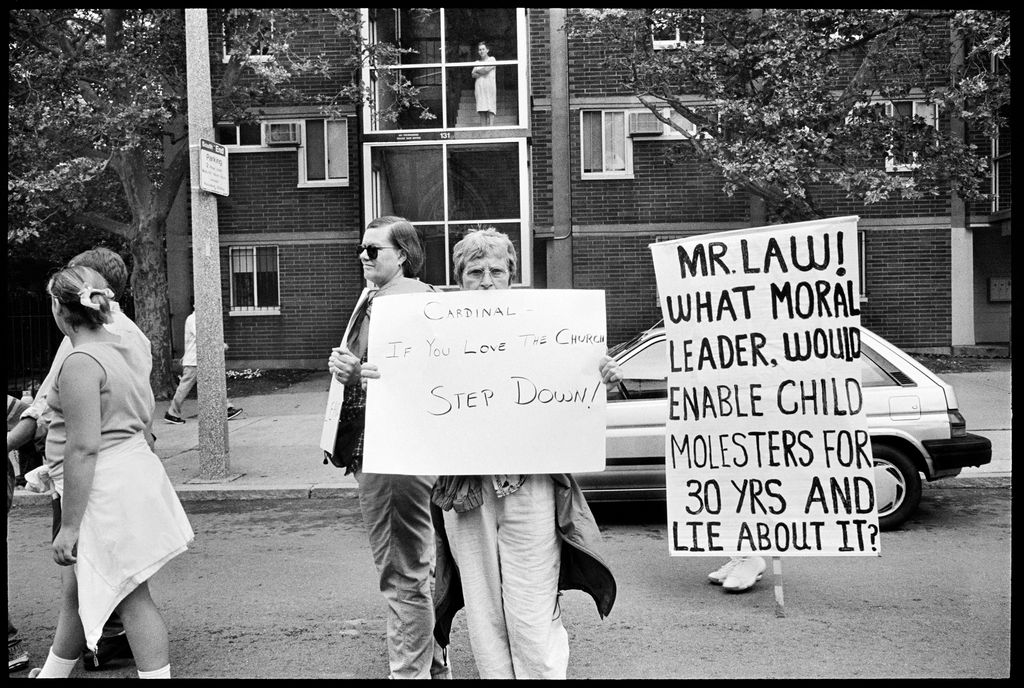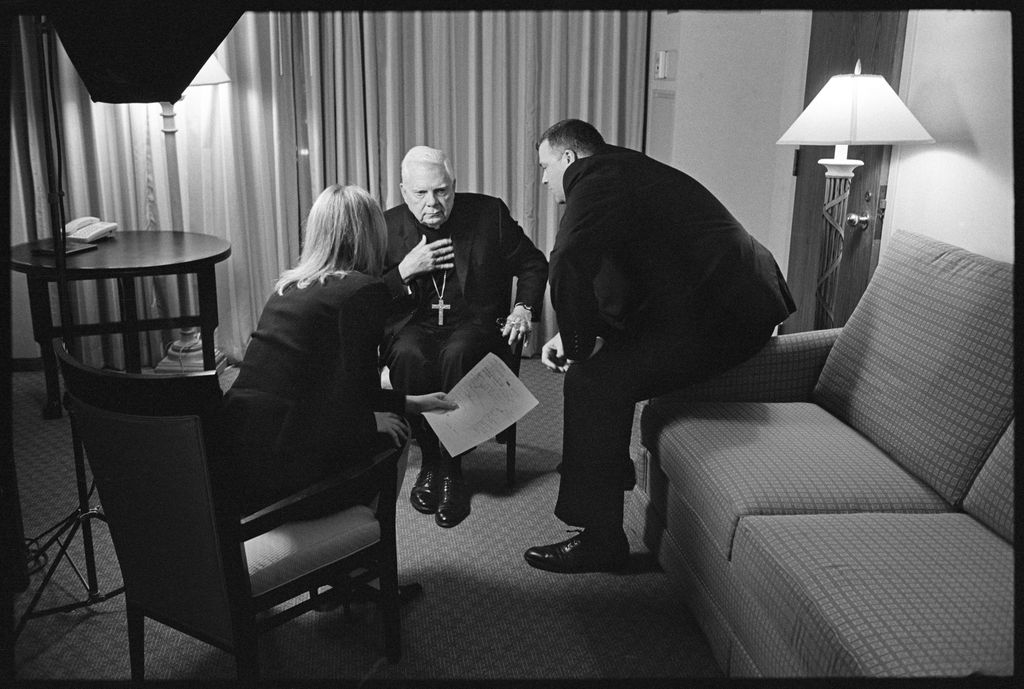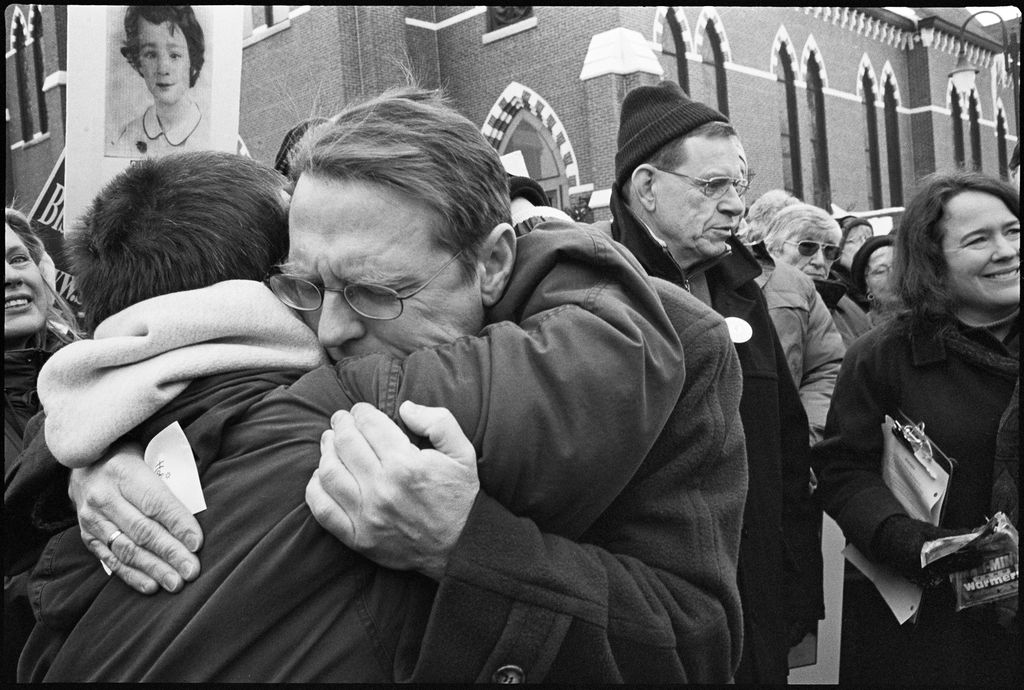BOSTON (MA)
Boston Globe
March 3, 2022
By Cate McQuaid
‘Heart in the Wound,’ at Howard Yezerski Gallery, revisits a painful chapter of the city’s history
[Photo above: Lisa Kessler, “Solidarity” (2003). Over 200 people at a demonstration demanding that Bishop John McCormack resign, including survivors Kathy Dwyer and David Clohessy, executive director of the Survivors Network of Those Abused by Priests. At right is Rev. Tom Doyle, a priest and canon lawyer whose 1985 report warning the Catholic hierarchy of the potential scope of the sex abuse scandal was ignored, and Anne Barrett Doyle, cofounder of Bishop Accountability. Manchester, N.H., January 2003. ©LISA KESSLER, COURTESY HOWARD YEZERSKI GALLERY ]
Twenty years ago, as the Globe’s Spotlight Team broke explosive stories about clergy sexual abuse of children, protests erupted outside the Cathedral of the Holy Cross, blocks away from photographer Lisa Kessler’s studio. She picked up her camera and went to the demonstrations.
“I felt like I had to be there. I was the only person, certainly the only photographer, with access to all the different players,” said Kessler, who is not Catholic. She had spent most of the 1990s as a photographer of record for the Archdiocese of Boston, traveling with church hierarchy and shooting for the Boston Pilot, the archdiocese’s official newspaper. Kessler, who grew up on Long Island, hadinterned for the Pilot while getting her master’s degree in journalism at Boston University, and shecontinued freelancing there for years.
In January 2002, “Seeing the people out on the streets so angry, I just did what I know how to do, which is to show up and look and listen,” said Kessler, 59, during arecent interview in her South End studio.Get The Big To-DoYour guide to staying entertained, from live shows and outdoor fun to the newest in museums, movies, TV, books, dining, and more.Enter EmailSign Up
At the time, Kessler was no longer working for the archdiocese. After freelancing for the Anti-Defamation League and for the Globe, she was doing corporate and editorial photography and pursuing passion projects on the side. She didn’t know anyone on the Spotlight Team, and when the clergy abuse story broke, she had her own ideas about how to cover it.
For years, Cardinal Bernard F. Law protected priests who had sexually abused children, failing to remove them from the ministry, perpetuating a culture of abuse and silence, and ignoring the plight of the victims. The first Spotlight story revealed that the archdiocese was aware of priest John J. Geoghan’s predatory behavior as early as 1984 but still “shuttled him from parish to parish.”
Kessler went back to the archdiocese and put in a request to photograph Law through the scandal and fallout. Her request was granted, on the condition that her images wouldn’t appear in the news cycle.
The photographer agreed. Her purpose was not to sell photos, she told the Globe in February. She knew there was a deeper story, one that would take a long time to play out, about secrets and betrayal in a faith community.
“For those survivors to come forward the way they did and tell their stories, they really took big risks,” said Kessler, reflecting on the public reaction as the Spotlight stories came out. “There were big costs to a lot of them personally in their own lives. They lost jobs. They lost family. They were just judged as attacking the Church.”
“Everybody was torn up inside,” she added.
Kessler befriended and photographed grown survivors of clergy abuse. She followed Law, taking pictures of him. And she looked for ways to frame the painful story.
“Heart in the Wound,” an exhibition of photographs from before and after the Spotlight Team’s revelations, is on view at Howard Yezerski Gallery. The show is new, but Kessler came up with the title for this body of work in the mid-2000s, after Fred Ritchin, then a photography professor at New York University, considered her working title, “Epicenter,” and suggested the images were about a wound.
The show’s driving force is the pain and courage of the survivors in the wake of abuse and the Church’s devastating indifference. You can see it in their faces.
“I was struggling, trying to capture the emotion from all the different people involved with my camera,” Kessler said. “But you know, Cardinal Law didn’t reveal a lot of emotion.”
In an e-mail, she condemned the “depravity, indifference and irreducible harm caused by his commitment to the institutional church and blindness to the experience of victims.”
Law resigned as Boston archbishop in December 2002 and later took a post in Rome, where he died in 2017.
In a recent interview with the Globe, Kathy Dwyer, who said she’s a survivor of abuse, talked about how she met Kessler at a protest and became a subject and a friend.
Kessler photographed Dwyer and David Clohessy, then national director of the Survivors Network of those Abused by Priests, embracing at a 2003 demonstration demanding the resignation of New Hampshire Bishop John B. McCormack, who had been a top aide to Law in Boston in the 1990s and later admitted to protecting the identities of abusive priests.
Dwyer took to Kessler quickly. “Some people were suspicious, but I sensed her energy was positive and honest and kind,” she said of the photographer.
“Sometimes my heart broke for her,” Dwyer added. “I wanted to give her some support, too — imagine working for these people.”
In the mid-2000s, Kessler made a short film featuring interviews with adult survivors of clergy sexual abuse. Some audio from that filmplays in the exhibition. The show features photos of everyday activities in the Church — choirboys relaxing before a performance; a young actor in costume for an Easter Passion Play napping in a pew — that, in the context of the scandal, seem foreboding.
Kessler recognizes the show may be triggering for some.
“What do you do with all the stuff that it churns up inside you? And what about all the people who have been affected in adjacent ways?” she said. “Maybe your family stopped going to church when you were a kid, but you didn’t know why.”
Gallery visitors may scan a QR code that will take them to a private page on Kessler’s website for viewers of “Heart in the Wound” to respond to the exhibition.
“I hope that people feel like it’s a little bit of a safe space to share,” she said.
Coverups of sexual abuse perpetrated by Catholic clergy continue to be exposed. Last fall, an independent inquiry commissioned by the French Catholic Church found that since 1950, approximately 216,000 children had been abused by Catholic clergy in France.
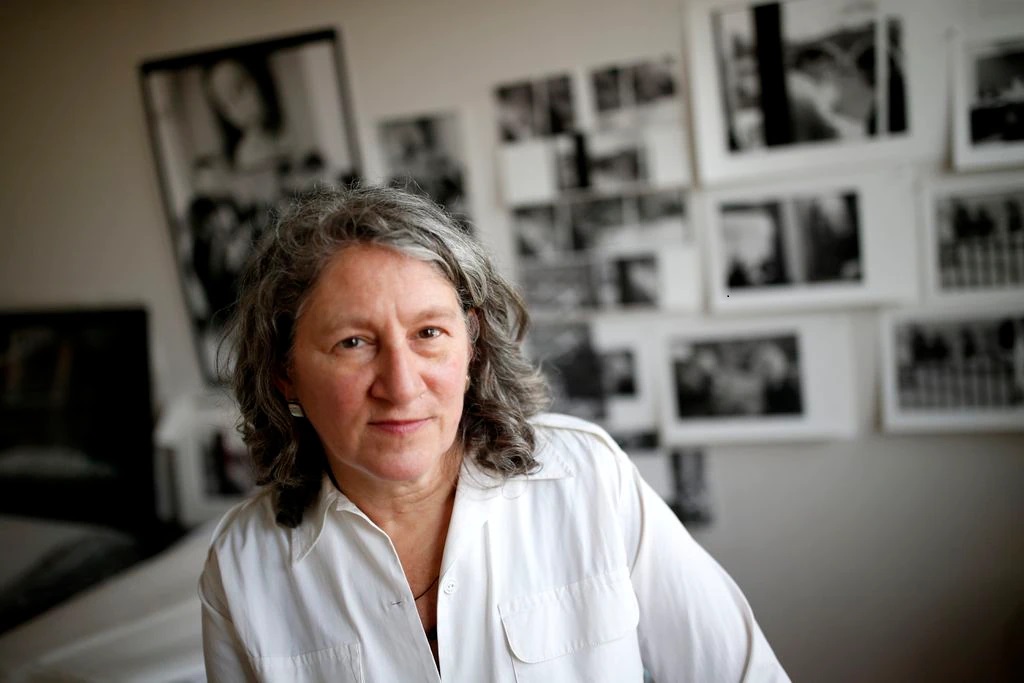
Kessler sees the activism prompted by the Spotlight coverage 20 years ago as a watershed moment for holding powerful people and institutions accountable.
“The survivors were really onto something. The way they were expressing themselves was historic and powerful,” she said. “I believe they were a transitional force between this old culture of silence and denial and secrecy and our current era, which is about reckoning and transparency and ‘Me Too’ solidarity.”
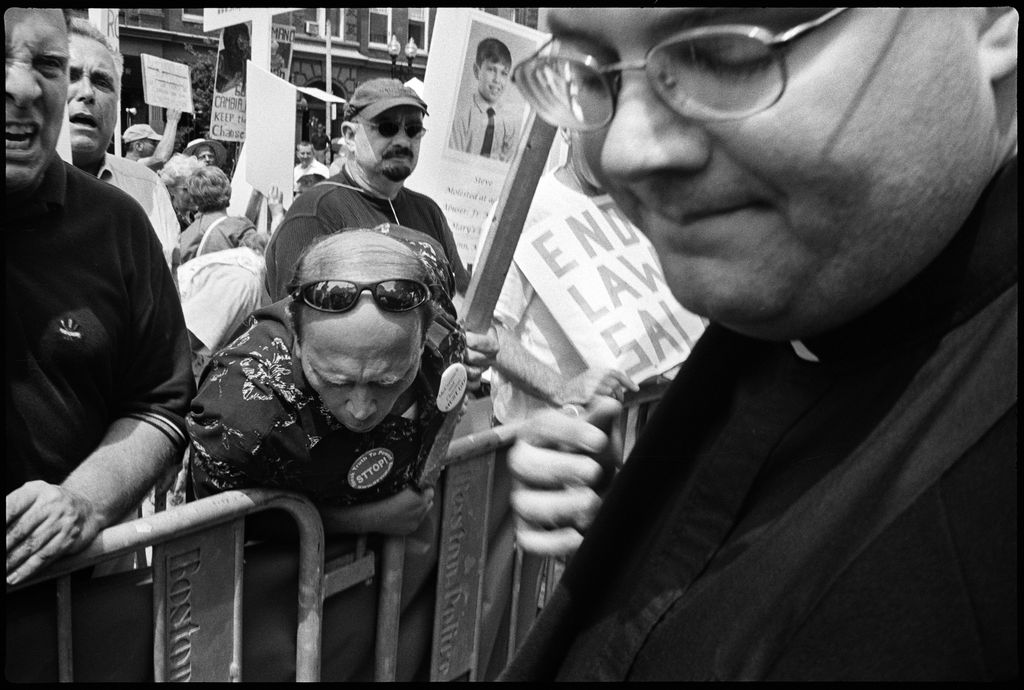
“It was here in Boston,” Kessler said, “where they turned the tide.”
HEART IN THE WOUND: Photographs by Lisa Kessler
At Howard Yezerski Gallery, 460 Harrison Ave., through March 26. 617-262-0550, www.howardyezerski.com
Cate McQuaid can be reached at catemcquaid@gmail.com. Follow her on Twitter @cmcq.
